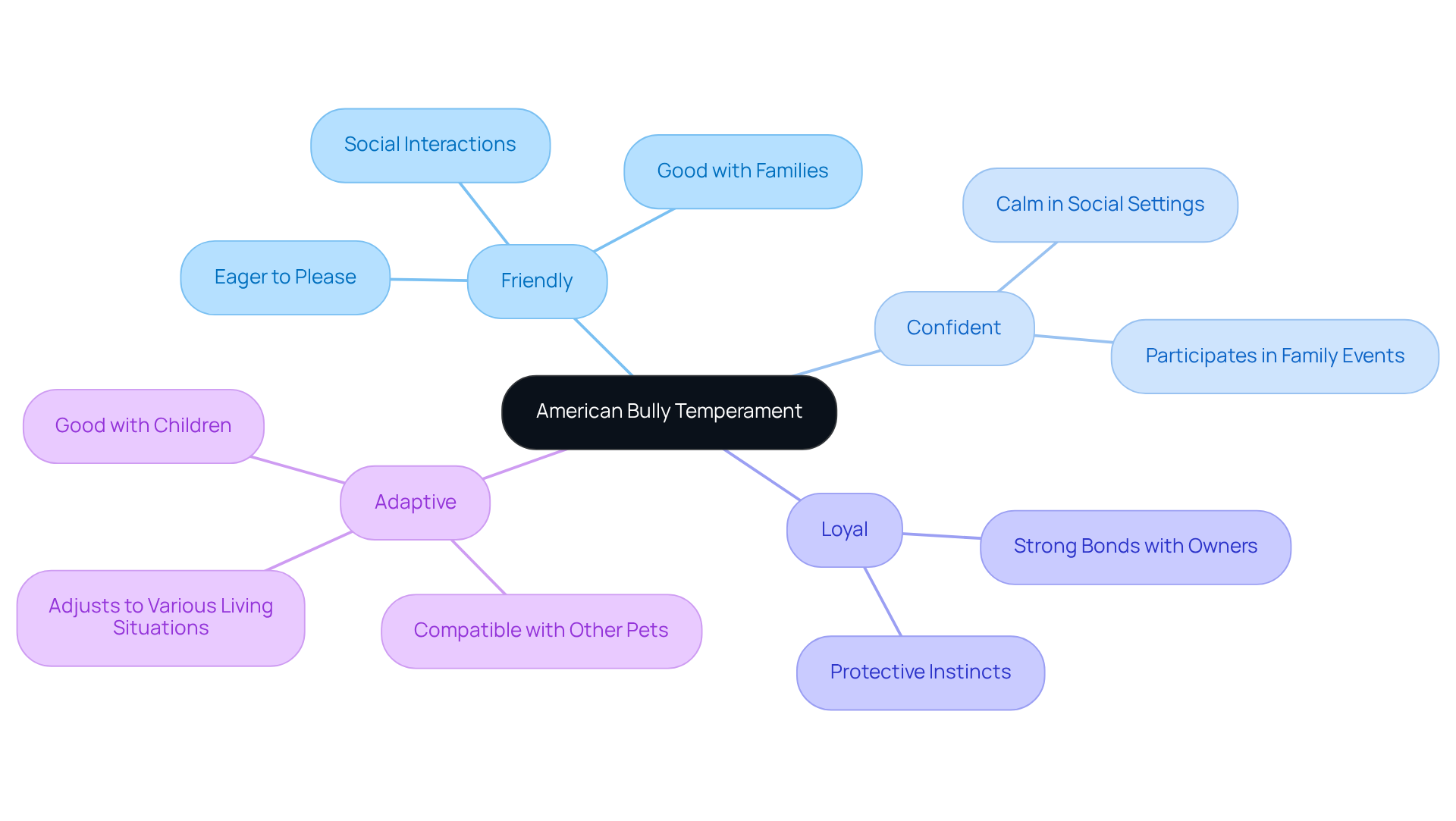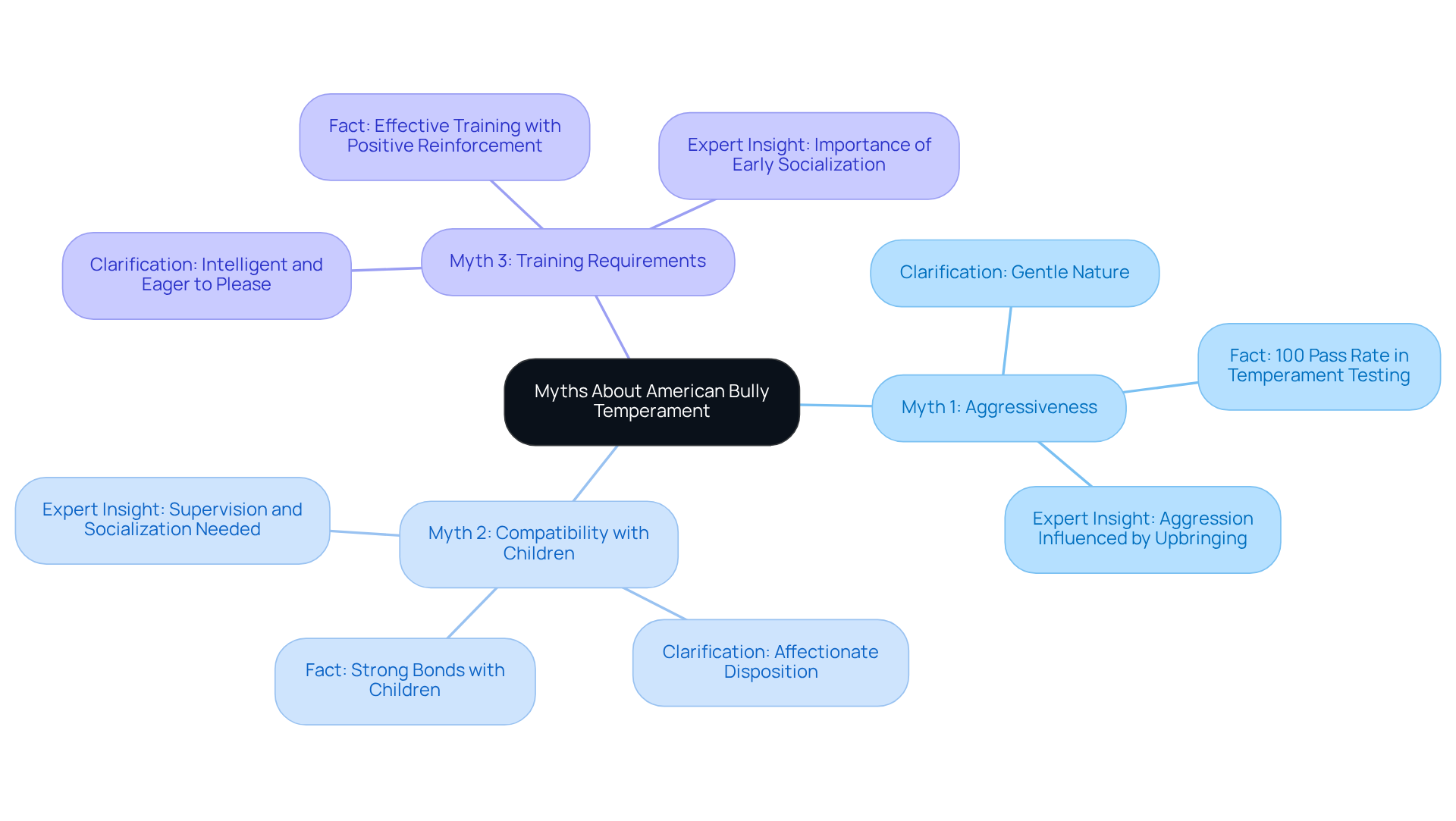Understanding American Bully Temperament: Origins and Key Traits
Overview
The temperament of the American Bully is truly heartwarming, characterized by its friendly, confident, and loyal nature. These wonderful traits make them exceptional companions for families, especially for those seeking a nurturing environment for their furry family members.
With a rich history as companion dogs, American Bullies score impressively on temperament assessments and display affectionate behaviors towards children and other pets. This all underscores their remarkable suitability as loving family members, ready to bring joy and companionship into your home.
Introduction
The American Bully breed has captured the hearts of many with its delightful temperament, marked by unwavering loyalty, playful energy, and a genuine eagerness to please. As families increasingly look for companion animals that embody these cherished traits, it becomes essential to delve into the origins and key characteristics of the American Bully.
Unfortunately, misconceptions about this breed often cloud its true nature, leaving potential owners uncertain.
What are the realities behind the American Bully temperament?
How can you, as a caring future owner, navigate these myths to create a nurturing environment for your furry family member?
Together, let’s explore the truth and foster a loving bond that lasts a lifetime.
Define American Bully Temperament
The temperament of the American bully breed is truly heartwarming, characterized by its friendly, confident, and loyal nature. These wonderful canines are celebrated for their loving disposition towards people and their eagerness to please, showcasing the American bully temperament, which makes them outstanding companions for families. Unlike certain breeds that may show aggression or aloofness, this type of bully typically thrives in social settings, eagerly participating in family events. The American bully temperament is shaped by their development as companion dogs, highlighting a harmonious blend of playfulness and calmness.
This adaptability makes them well-suited for various living situations, including homes with children and other pets. Recent studies, including data from the Temperament Test Society, reveal that the American bully temperament scores impressively high on temperament assessments, with an average score of 91.3%. This reinforces their reputation as loving family members, ready to be part of your nurturing environment. For instance, Edward Perez of Manmade Kennels wisely states, “Understanding a dog’s temperament is key to stopping dog aggression,” which highlights the importance of responsible ownership and care.
Proper socialization from a young age further enhances their friendly interactions with other pets, ensuring they grow to be well-adjusted and happy in their environments. By fostering these connections, you can create a loving atmosphere for your furry family members, allowing them to flourish in your home.

Explore the Origins of the American Bully
The Bully breed, developed in the United States during the 1990s, serves as a loving companion, with roots tracing back to the Pit Bull Terrier and the Staffordshire Terrier. Breeders aimed to develop a dog with the American Bully temperament that embodies loyalty and protective instincts while also fostering a sociable and friendly demeanor. Officially recognized in 2004, the Bully breed has blossomed in popularity, cherished for its gentle nature and strong familial bonds. This focus on companionship has profoundly influenced the American Bully temperament, establishing it as a beloved choice among dog owners.
Typically, Bullies enjoy a lifespan of 8 to 12 years and adapt well to various living conditions, including apartment life, as long as they receive ample exercise. These furry family members require about one hour of exercise each day to maintain their health and happiness. It’s also important for potential owners to be aware of common health concerns, such as hip dysplasia and skin conditions.
The trainability and social nature of the American Bully temperament further enhance its appeal, making it an excellent companion for families. Its growing presence across the country, where it has become one of the most popular breeds in 21 states, underscores its integration into local culture and family life. As this breed continues to evolve, its reputation as a loving and loyal companion remains firmly established, inviting you to consider welcoming one into your nurturing environment.

Identify Key Characteristics of American Bully Temperament
The affectionate nature of the American Bully temperament is truly reflected in its key characteristics. Renowned for forming strong bonds with their families, these dogs make ideal companions for your furry family members.
They are playful, thriving on playtime and requiring regular exercise to maintain both physical and mental health. Daily activities are essential, as they can become bored and exhibit destructive behaviors without sufficient stimulation. They delight in toys and games that challenge their intelligence, further emphasizing their playful spirit.
Confidence is another hallmark of this breed. Their self-assured demeanor can sometimes be misinterpreted as aggression if they are not properly socialized from a young age. Early socialization is crucial—it not only counters any potential aggression but also builds their confidence and adaptability.
Intelligence shines through as well. Recognized for their rapid learning skills, American Bullies respond remarkably well to training, especially when positive reinforcement methods are utilized. This intelligence makes them relatively easy to train, provided they receive consistent guidance.
While usually amicable, they also possess a protective side. This breed can be defensive of their families, demonstrating loyalty and attentiveness. This trait, combined with their affectionate nature, makes them excellent guardians for households.
The typical lifespan of Bullies ranges from 8 to 13 years, a significant factor for families seeking a long-term companion. These traits together enhance the American Bully temperament, making it a caring and playful family pet that can flourish in various living situations as long as their exercise and socialization needs are fulfilled. As Heather Logue notes, “Despite their muscular (and sometimes even intimidating appearance), these dogs are friendly, sweet, and goofy – and are especially affectionate with children.

Debunk Myths About American Bully Temperament
Numerous myths about the American Bully temperament warrant clarification, especially for those considering welcoming this loving breed into their homes.
- Myth 1: American Bullies are aggressive: This stereotype often arises from their muscular build. In reality, the American Bully temperament is usually gentle and friendly, especially when they are given appropriate socialization from a young age. Research indicates that many bully types, including those characterized by the American Bully temperament, rank higher in stability and friendliness compared to other well-loved breeds. In fact, U.S. Bull breed dogs achieved a perfect 100% pass rate in standardized temperament testing by the Temperament Test Society (ATTS), highlighting their American Bully temperament and inherently friendly nature.
- Myth 2: They are not good with children: On the contrary, the American Bully temperament is known for its affectionate disposition and ability to form strong bonds with children. When raised together, they often become excellent companions, demonstrating patience and gentleness. Their playful demeanor exemplifies the American Bully temperament, making them ideal for active families, as they thrive on 30-60 minutes of moderate daily exercise, which can include engaging playtime with children.
- Myth 3: They require extensive training to be well-behaved: While training is essential for any dog, this breed is intelligent and eager to please, making them relatively easy to train. Consistent positive reinforcement methods can lead to effective training outcomes, fostering trust and communication between the dog and owner. As Dr. Irah Pearl Acierto emphasizes, responsible pet ownership and early socialization are crucial in developing the American Bully temperament.
By debunking these myths and incorporating expert insights, potential owners can gain a clearer understanding of the true nature of American Bullies. This knowledge empowers them to make informed decisions about welcoming their furry family members into a nurturing environment.

Conclusion
The American Bully temperament shines as a beautiful blend of friendliness, loyalty, and adaptability, making these dogs truly exceptional companions for families. With their heritage rooted in the Pit Bull and Staffordshire Terrier breeds, American Bullies have been lovingly developed to embody a disposition that thrives in social settings. Their affectionate nature, paired with their confidence and intelligence, positions them as ideal family pets, seamlessly integrating into various living environments.
Throughout this article, we have highlighted key characteristics such as playfulness, trainability, and protective instincts, showcasing the breed’s suitability for active households. The importance of early socialization and responsible ownership has been underscored, ensuring these dogs grow into well-adjusted companions. Moreover, by debunking common myths about their temperament, we reveal the truth behind their gentle nature, countering misconceptions that often overshadow their reputation.
Ultimately, understanding the American Bully temperament is vital for potential owners eager to welcome a furry friend into their lives. By appreciating the breed’s affectionate and loyal characteristics, individuals can cultivate a nurturing environment where these dogs can truly thrive. Embracing the American Bully not only enriches family life but also fosters a broader understanding of this often-misunderstood breed, encouraging responsible pet ownership and a heartfelt commitment to their well-being.
Frequently Asked Questions
What is the temperament of the American Bully breed?
The American Bully breed is characterized by a friendly, confident, and loyal temperament. They are known for their loving disposition towards people and eagerness to please, making them outstanding companions for families.
How do American Bullies behave in social settings?
American Bullies typically thrive in social settings and eagerly participate in family events, showcasing their friendly nature. Unlike some breeds that may show aggression or aloofness, they are well-suited for various living situations.
What does research say about the temperament of American Bullies?
Recent studies, including data from the Temperament Test Society, show that American Bullies score impressively high on temperament assessments, with an average score of 91.3%, reinforcing their reputation as loving family members.
How does socialization affect the American Bully’s temperament?
Proper socialization from a young age enhances American Bullies’ friendly interactions with other pets and people, ensuring they grow to be well-adjusted and happy in their environments.
Why is understanding a dog’s temperament important?
Understanding a dog’s temperament is crucial for responsible ownership and care. Recognizing their temperament helps in preventing dog aggression and fostering a loving atmosphere for pets within the home.







